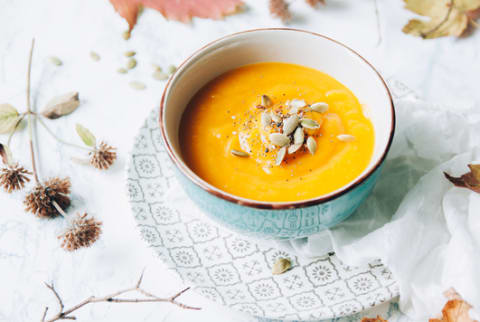Advertisement
The Sneaky Foods That May Be Causing Inflammation & Weight Gain

As part of the Your Body at Its Best series, I'm showing you how to clean out and detox your kitchen so you can fight inflammation and identify which foods may be wreaking havoc on your body.
The right foods for you should make you feel satisfied and energized, not sick and sleepy. There is no preordained, across-the-board "right," just what's right for you. Your friend, trainer, or mother may swear that quinoa is king, but if it makes you feel ill, pass on it.
Foods have so much more to them than calories, and yet many people think caloric intake is the bottom line. Au contraire, my friend—there is more to cracking the weight-loss code!
The number of calories a food has is merely information, and as with any other kind of information, less isn't necessarily better, just as more isn't necessarily bad. A 100-calorie snack pack of crackers is in no way equal to 100 calories of walnuts. Counting calories is the last thing you should worry about when you're trying to eat a clean, anti-inflammatory diet.
Food in its whole form is the healthiest version. In fact, the majority of what you eat should have one ingredient. What's in broccoli? Broccoli. What's in an apple? An apple. If most of your meals come from a box, then it's worth rethinking your diet.
It's easy to assume that when you cut out inflammatory foods from your life, your world gets smaller, but in practice it's quite the opposite. Living a clean, anti-inflammatory lifestyle is not restricted eating; it's an adventure beyond the box. It's getting outside of your old habits and all the problems they bring with them.
Start by adding in a few anti-inflammatory foods and removing a few of the inflammatory foods each week until your pantry and fridge are full of clean, whole foods. Use the below as guides on which foods to enjoy—and which to avoid—as you incorporate more anti-inflammatory foods into your diet. If this seems overwhelming, plans such as the NutriBullet LEAN eliminates foods which many people find inflammatory while focusing on the right balance of food: low-sugar fruits, vegetables, healthy fats, and lean proteins.
Anti-Inflammatory Foods:
- Gluten-free whole grains: brown rice, wild rice, black rice, millet, amaranth, quinoa, gluten-free oats, and sorghum
- Whole grain and nut flours: whole grain flours, almond flour, coconut flour, chickpea flour, quinoa flour
- Full-fat coconut milk, unsweetened almond milk, hemp milk
- Beans and legumes
- Honey or pure maple syrup
- Organic leafy greens (kale, Swiss chard, spinach, collard greens, arugula)
- Detoxifying veggies (broccoli, Brussels sprouts, cauliflower, cabbage)
- Berries
- Avocado
- Protein-packed breadcrumbs: I use the NutriBullet LEAN blender to make my own healthy breadcrumbs. Place raw walnuts, almonds, and sea salt in your food processor and whirl them around until they form a very fine crumb consistency. Use these crumbs in place of starchy breadcrumbs.
- Organic and grass-fed animal products (turkey, chicken, lamb, wild salmon), if you're not vegan or vegetarian
- Extra-virgin olive oil, extra-virgin coconut oil
- Raw or sprouted nuts and seeds: walnuts, almonds, Brazil nuts, hazelnuts, pecans, sunflower seeds, pumpkin seeds, ground flaxseeds, hemp seeds, chia seeds, sesame seeds (including nut/seed butters)
- Spices and herbs: cinnamon, ginger, turmeric, fresh cilantro, fresh parsley
- Sea salt
How to easily incorporate anti-inflammatory foods:
- Puree veggies. Add steamed and pureed carrots, squash, parsnips, rutabaga, pumpkin, sweet potato, or zucchini to sauces for silkiness. Use the Nutribullet LEAN blender to puree these veggies.
- Add creaminess without dairy. Add ripe avocados to thicken up soups. You can also remove the dairy-filled cheese from your pesto recipe and use ripe avocado instead. Swap out pine nuts for walnuts and you'll add a dose of anti-inflammatory omega-3s, too!
- Boost the flavor. Add fresh herbs to stews, homemade hummus, salad dressings, and marinades instead of adding sugar.
- Try coconut milk. Add full-fat culinary coconut milk to soups and smoothies to create a creamy and thick consistency without butter or cream.
- Toss in fluffy whole grains. Add a few scoops of cooked quinoa or millet for richness in a chili or porridge.
Inflammatory Foods:
- Processed foods (any food that comes in a box or bag with ingredients you cannot pronounce)
- Refined grains: white rice, white bread, all-purpose white flour
- Store-bought breadcrumbs
- Refined sugar (white sugar, brown sugar)
- Sugar substitutes (artificial sweeteners)
- Low-fat/Fat-free dairy and butter substitutes
- Conventional/Non-organic animal products (dairy, eggs, turkey, chicken, red meat, farmed salmon, canned meats)
- Soy (including soy milk, cheese, etc.)
- Canola oil (and other refined vegetable oils)
- Corn
- Salted peanuts and candied nuts
- Refined table salt
- Alcohol
How to avoid inflammatory foods:
- Cut out the flour and sugar. These are highly inflammatory. Toss those white flours and all-purpose flours!
- Eat lots of fruits and vegetables. Choose a variety of colorful fruits and vegetables.
- Reach for healthy fats. Omega-3 fatty acids are the way to go. Reach for wild salmon, walnuts, almonds, ground flaxseeds, coconut oil, and extra-virgin olive oil.
- Beware of nonorganic soy. You can experiment with soy to see how it affects you, but many people find they can't tolerate soy after removing it for a few weeks. If you eat soy, always chose non-GMO.
- Get rid of gluten. Gluten can contribute to numerous health issues including leaky gut and other autoimmune diseases. Best to avoid it and choose the naturally gluten-free options listed above (not the processed gluten-free products that are often full of inflammatory ingredients).
- Eat one-ingredient whole foods. Toss the processed foods and stick to foods in their whole form!
- Start slow;y. Don't get overwhelmed and think you have to remove every food from your pantry today. Start slowly by removing all the processed condiments from your fridge this week and instead use fresh citrus juices and fresh herbs. Next week toss the processed cereal or bread in your pantry and replace them with whole grain options. You can do this for every item in your pantry and fridge.
Learning about anti-inflammatory foods has brought me to where I am today, feeling whole, healthy, and strong enough to reconnect with the world. My body healed because I changed the way I ate and started incorporating more whole, anti-inflammatory foods into my daily meals.

New Study Confirms The 3 Habits That Age Your Brain Faster
Molly Knudsen, M.S., RDN

















